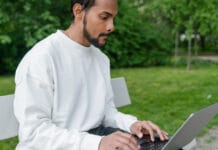Snort. Who worries about labeling well?
Well, if you don’t, now is not too late to start. And we promise: the result of this little extra care will pay off well when you want to find something in the 20+ boxes you have at your house or a self-storage facility.
Truth is: the size of the house doesn’t matter; you’ll always have a lot of stuff. And when it comes time to move, you’ll be overwhelmed by the sheer quantity of it and question why you ever thought this was a good idea. Not labeling well will only add to the stressful nature of the process.
Because the thing is: most people are prone to taking a haphazard approach to moving and storing. They’ll take the easiest way out (as is typical human nature) and not invest a few extra minute or resources to make things more comfortable and organized in the long run.
The Subtle Art of Labeling Well
When you label your boxes well while moving, you achieve three things:
- You keep your items well-organized
- You find those items quickly and efficiently
- People handle them like they should be handled
Think of your delicate vases, your imported chinaware, and the antique jewelry box gifted by your grandmother. The above three points will hold more significance then.
While labeling, it is important to remember the three characteristics of every label. Namely:
- It should be legible
- It should not come off containers and boxes while moving
- It should be easy to edit and replace
So how do you go about labeling boxes in a way so as that all of the above points are covered? Follow the guidelines below:
Gather your labeling supplies
These include materials like:
- Glue
- Tag holders
- Color markers
- Color labels
- Masking tape
- Packing tape
Decide on a labeling system
Instead of using bland white paper to cut out slips and scribble labels upon, choose an appropriate labeling system. You can select one of the following:
- Numeric labeling system
Conventionally, you would think that you need to write down every item that the box contains, on the paper.
Now supposing you have a box full of mountaineering gear- ropes, helmets, boots, etc. etc. Listing every item in the box means you’ll have to tack a long list to the box at the end. This is where the numeric system can be a savior.
You label the boxes numerically- 1,2,3, and so one. Then, one a single Master Sheet you write the number and against it, you write the contents of the box. For example, if box number 5 contains mountaineering gear then, in the Master Sheet, you make an entry for both of them in a single row in separate columns.
This way, you won’t need to change labels on the box. You can simply update the contents in the Master Sheet.
- Color-coded labeling system
This one is great for quickly finding the stuff you need.
Decide on a color for a particular set of items. For example, green could be for gardening, pink for kid’s stuff, and yellow could be for clothes, and so on.
Once the colors are decided, use the appropriate colored markers, tape, and labels for packing up the boxes. That means you use green masking tape, a green packing tape, and a green marker when boxing up gardening items. You can also use a green post-it and write the contents with a black marker on it.
The best thing about this system is that in a sea of boxes, it’ll be almost effortless to find the right box if you have the color right- no need to go over white labels over each of the boxes.
Specify the contents
As clearly as possible. Instead of writing ‘paintings’ on the box, specify which paintings are in the box, in the order in which you kept them. Ideally, they’ll all of a uniform size. Mention that, too. If not, write the size against the painting name.
Specify handling directions
No matter the labeling system you choose, you must always specify the directions for handling the contents of the box. Fragile, expensive, delicate, or sensitive items need to be handled carefully. You cannot go around telling everyone to remember which boxes contain these items, but you can write ‘fragile,’ ‘this side up’ with a black/ red marker so that the information is conveyed.
How to Use Labels: Ensure the safe handling of your fragile items, expensive, delicate, or sensitive items by clearly marking boxes with ‘fragile’ and ‘this side up’ instructions using a black or red marker.
What if I am storing stuff?
If you are taking your items to a self-storage facility for safekeeping (due to downsizing, renovation, relocation) for any period, then you’ll want to go for plastic storage containers.
Storage boxes specific tips
- Never stick the label to the top of the box. If the boxes are stacked on top of another (which is highly likely), then you still need to read the contents. Hence, paste the label on the side.
- Never use pencils or erasable markers for labeling. They can wear off pretty quickly, and then you’ll have to sit down, unpack each box to see what’s inside it and label it again.
- Ensure that the label has stuck properly to the box from all four sides. You don’t want friction due to contact from other boxes to tear away the label. Use the tape generously.
- Make the labels easy-to-read and clear in legible handwriting.
There you have it. A short, simple, complete guide to the art of labeling, meant to smoothen your moving and storing process. Try it once and see it work its magic for yourself!







